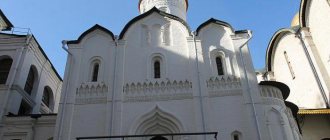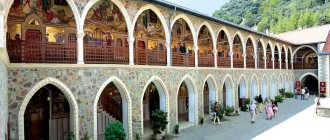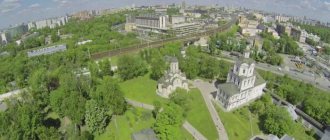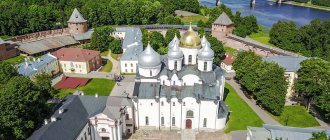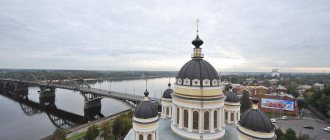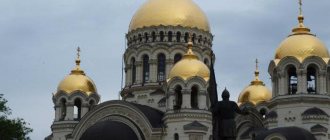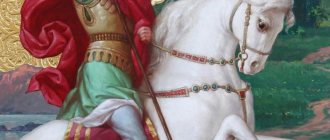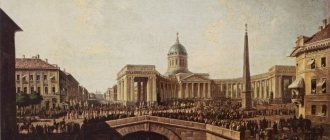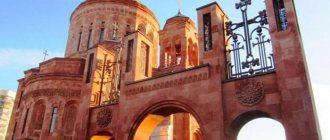The Tithe Church in Kyiv is a place today that is more historical than religious. From the first Christian temple of Rus', built of stone, all that remains is the foundation excavated by archaeologists and stands with information for all those interested. And its location, as well as its surroundings, invites you to plunge into the past of the “mother of Russian cities”: Starokievskaya Mountain is the historical center of the Ukrainian capital, two steps from the excavations of the foundation there are the ruins of the palace in which Prince Vladimir lived, the Museum of the History of Ukraine, linden, whose age has exceeded 500 years, as well as a place marked with a stone with the chronicle quote “From here the Russian land came.” It was here, according to archaeologists, that the first buildings of Kyiv were located.
A visit to the Church of the Tithes can, however, be included not only in the historical, but also in the religious route. 700 meters south is the St. Sophia Cathedral, and there are several temples in the area. In addition, across the road from the territory with the foundation of the Church of the Tithes, on the square with the monument to St. Andrew the First-Called, there is a museum “Spiritual Treasures of Ukraine”. If you are exclusively interested in the first stone Christian church in Rus', take a look at the nearby Museum of the History of the Tithe Church (Vladimirskaya Street, 6/1). A guided tour will give you a complete understanding of the fate of the temple.
Historical foundation overlooking Desyatinnaya Street, © Prymasal
Construction of the Tithe Church in Kyiv
The construction of the Tithe Church began soon after Russia adopted Christianity. The choice of location for the religious building is explained not only by its proximity to the princely palace, but also by the special significance of the territory: in 978, Theodore Varangian and his son John were killed here, who later came to be considered the first Russian martyrs for the faith. Some researchers believe that it was their fearless steadfastness in confronting the pagans that pushed Prince Vladimir Svyatoslavovich to religious reform.
Construction of the temple began under Vladimir I. According to some sources, the construction of the church began in 989, according to others - in 990 or 991. The work took 6 years.
The ceremony of laying the cornerstone, which marked the beginning of construction, was solemn. Present were not only church hierarchs led by Bishop Leonty, but also boyars and ordinary residents of Kyiv. In their presence, Prince Vladimir declared that the church would be built with a tenth of the income from the lands he ruled. Thus, the definition of “Tithe” was assigned to the temple, originally dedicated to the Mother of God.
The temple stood on the main trading square; it was decorated not only with icons and church utensils, but also with expensive vessels from Chersonesos. The building was decorated with white marble, and the western entrance was decorated with bronze statues of horses. The first rector of the Tithe Church was the confessor of Prince Vladimir, Anastas Korsunyanin. Subsequently, a princely tomb was created in the temple. For some time, the relics of Vladimir, as well as his brothers Yaropolk and Oleg, were kept in it.
In the 12th century, the church was partially destroyed due to an earthquake and survived 2 lootings during internecine wars. In 1240 it was finally destroyed by the troops of the Tatar-Mongols. The ruins lay untouched for 4 centuries, until in the 16th century fragments of marble were dismantled for the construction of churches.
The revival of the temple began under the first Romanovs. The initiator was Metropolitan Peter Mohyla. In 1635, under his leadership, the first excavations took place, and the relics of Prince Vladimir were discovered and reburied in the St. Sophia Cathedral. Around the same time, a small church of the Nativity of the Blessed Virgin Mary was erected at the southwestern corner of the foundation. It stood until 1828, when they decided to dismantle it in connection with the restoration of the main Tithe Church.
Information stand next to the remains of the church foundation, © Maria Chakhnashvili
The creation of the third temple was preceded by large-scale excavations that started 4 years before construction. In the process, the plan of the foundations was completely discovered, and the remains of frescoes and mosaics created in the 10th–11th centuries were found. The construction of the new Tithe Church took 14 years, and was led by the St. Petersburg architect, academician of the Imperial Academy of Arts Vasily Stasov. He did not recreate the appearance of the first temple, but relied on a new building design in the Russian-Byzantine style.
Consecrated in 1842, the Tithe Church stood for less than a century: it was destroyed under Soviet rule and by 1936 it was finally dismantled. However, in subsequent years archaeological excavations were carried out here several times. In the 2000s, the question of reviving the Church of the Tithes was raised more than once, but in the end the idea was rejected, since there was no complete information about the first appearance of the building. In addition, in 2011, UNESCO opposed the construction of a new temple on a historically valuable foundation. Its remains were opened for viewing by everyone.
Getting to know an architectural masterpiece
One of the special memorable places located in the very heart of Kyiv is the Tithe Church. It is also called the Church of the Assumption of the Blessed Virgin Mary. It became one of the first stone buildings in the city, about which many literary essays remain. It was mentioned in archives, in ancient manuscripts and other documents.
Despite the large number of sources, none of them contains clear images of what the oldest church in Rus' originally looked like. Only from a number of archaeological finds found in different periods can we guess what it was like. For example, a fragment of the entrance and part of the building was depicted in one of the drawings of 1826. However, according to scientists, the ruins depicted in the picture are only a copy of a drawing left by the Dutch painter, calligrapher and draftsman Abraham Van Westerfeld.
What to see nearby
In the building next to the remains of the church foundation there is a museum dedicated to the first stone Christian church in Rus'. Excavation materials are exhibited here and thematic excursions are held.
For a more extensive acquaintance with the history of Kyiv, it is recommended to visit the National Museum of the History of Ukraine, rising 100 meters from the remains of the foundation of the Church of the Tithes. Collections of weapons, coins, dishes, works of art, archaeological artifacts dating back to the turn of the century, and ancient documents, some of which were created more than 700 years ago, are exhibited here.
Remains of the Tithe Church in front of the Museum of History of Ukraine, © Maria Chakhnashvili
To the south of the National Museum there is a park with a “Landscape Alley”, famous for unusual sculptures like the “Centipede Cat” and the “Rubik’s Cube”. If you go from the museum to the north, you can get to Andreevsky Descent Street - a 10-minute walk on it there is the Bulgakov Museum and the Theater on Podol.
In the eastern part, closer to the Dnieper, behind the buildings of the “Spiritual Treasures of Ukraine” museum, the district court and the Ministry of Foreign Affairs, there is a walking area with observation platforms from which a panorama of the embankment opens. If you move along the alleys to the south, you can reach the funicular station and the Vladimirskaya Gorka park with a monument to the prince.
Near the station is the St. Michael's Golden-Domed Monastery with a cathedral and a large square in front of it. There is a sculptural group with statues of Princess Olga, Cyril and Methodius, and St. Andrew the First-Called on it. The tiled pedestrian St. Michael's Square with golden domes above the azure walls of the cathedral is one of the most beautiful places in Kyiv.
Presumable description of the building
As already noted, no reliable photographs or drawings depicting the church were found. As a result, based on various sources and archaeological finds, one can only guess what it was like. Thus, many archaeologists and historians believe that this church was a cross-domed building on four pillars. The architecture of the Church of the Tithes, in their opinion, fully corresponded to the architectural model of Byzantine art.
Presumably, next to the multi-domed religious building there were mansions of the Kyiv nobility, courtyards and a princely palace. Also relatively nearby was a square called Babin Torzhok. According to some reports, it was here that active international trade was once conducted.
Architecture and interior
The Church of the Savior on Nereditsa is a wonderful architectural monument that embodies the collective image of Novgorod architecture of the last third of the 12th century with features characteristic of that time, but at the same time has a unique artistic image and its own charm.
This is a small, single-domed, three-apse, cubic-type temple with a roof covering and laconic decorative design.
On the eastern side there are three altar projections, with the side apses lower than the central one, and this distinguishes Nereditsa from all previously built churches.
The temple is crowned with a rather large helmet-shaped head on a drum, the upper part of which is decorated with a traditional Novgorod arcature frieze.
The facades, divided into three sections by flat blades, are designed simply and laconically. Small arched windows, in accordance with the tradition of that time, are arranged pyramidally.
Previously, a small vestibule was adjacent to the western facade of the building.
Western façade. Entrance to the church. (A wooden box next to the church covers the remains of a bell tower built in the 18th century and destroyed during the war.)
The interior space is divided by four square pillars supporting the vault.
In the western part of the temple there are spacious choirs on a wooden ramp. A narrow staircase located inside the wall leads to the choir.
Door and staircase to the choir
Unlike earlier buildings, only the middle part of the choir is open to the inside of the church, and the side parts are separated from the transept by a blank wall, forming small corner rooms. In the southwestern corner room in the choir there is a small arched apse niche in the wall - probably a chapel was built here.
With the exception of the walled aisles in the choirs, the entire interior can be seen from one point, and you do not need to move around the temple to see it.
There are no dividing blades on the inner surface of the walls, which makes the interior space of the building simpler and less dismembered.
It is interesting that, despite the wartime destruction, some of the original wooden structures survived: the door frame and the door to the staircase leading to the choir, the rolling floor in the northern part of the choir, the beam above the entrance to the diaconium.
Old wooden beam above the entrance to the diaconium
Even an original wooden window was discovered - it is now in the State Historical Museum - based on the model of which the current window fillings of the temple were made.
In the lower part of the walls in the altar part and in the western part of the temple under the choirs there are semicircular niches - these are funeral niches-arcosolia. The church was intended for the eternal commemoration of the sons of Prince Yaroslav Vladimirovich and in the future, probably, was to become a tomb for the princely family.
In the chronicles, however, there is no information about any of the family members of Yaroslav Vladimirovich buried here. In 1322, at the entrance to the diaconium, Prince Afanasy Danilovich, grandson of Alexander Nevsky and brother of Moscow Prince Yuri Danilovich, who reigned in Novgorod from 1319 and before his death, took monastic vows in the Nereditsky Monastery, was buried in a stone sarcophagus.
The building was erected using the mixed technique characteristic of Novgorod architecture of that time: it is masonry made of alternating rows of limestone and plinth (thin baked bricks) on lime mortar with cement (i.e., with an admixture of brick chips). Moreover, the masonry of the walls is quite loose and the order is not strictly maintained everywhere: for the most part one row of bricks alternates with one row of limestone, but in some places bricks are found less frequently, every other row.
Plan of Spas-on-Nereditsa
The Church of the Savior on Nereditsa was not distinguished by geometric precision of lines and shapes; the curvature of the lines, the unevenness of the planes, the beveled corners - all this gave the building a special plasticity.
The length of the temple is 15.7 m, width 11.4 m, the space under the dome is 4.04 x 3.5 m. The height of the building from the level of the ancient floor to the center of the dome is about 18 m. The thickness of the walls is about 1 m.
The flagstone from which the walls are made cannot be processed perfectly, and therefore the surface remains slightly uneven and rough.
Vocals in the form of clay jugs were placed in the walls and vaults.
The floor of the temple was paved with multi-colored glazed ceramic tiles and, in places, bricks.
The foundation, a little more than half a meter deep, is made of cobblestones.
Foundation and old masonry
There is no exact information in written sources about the architect who built the temple on Nereditsa. But researchers suggest that it could be master Korov Yakovich “from Lubyanya Street.”
At the end of the 12th century, stone construction in Novgorod was carried out mainly by order of the archbishop, the head of the Novgorod church, and, probably, by a permanent team of craftsmen. From chronicle documents it is known that in 1196, when the Church of the Resurrection was erected by order of the archbishop, at the same time, by order of the residents of Lubyanka Street, master Korov Yakovich, who lived on the same street, built the Church of St. Kirill in the Kirillovsky Monastery. That is, in 1196, two artels of craftsmen worked in Novgorod: one carried out the order of the archbishop, and the other, headed by Korov Yakovich, built according to the orders of the townspeople.
In the summer of 1198, the archbishop's artel was busy in Russa, and therefore, perhaps, the princely order - the construction of the Transfiguration of the Savior on Nereditsa - was carried out by Korov Yakovich with his masons. The Savior on Nereditsa is close in plan and volume-spatial design to the St. Cyril Church he built. However, there is no evidence of authorship, and there could have been other construction cooperatives in Novgorod at that time.
During Soviet times the church was destroyed
With the advent of the new government, a new misfortune came. The Bolsheviks opposed religion and began to uncontrollably destroy places of worship.
Whatever was proposed to be placed in the shrine. On October 2, 1929, the Tithe Church was closed, without creating either a museum or a club from it.
And in March 1936, the presidium of the Kyiv City Council made a decision to demolish the Tithe Church as having no historical value.
Contours of the foundation of the Tithe Church
All that was saved were the archives of the Tithe Church, which were sent to the Sofia Architectural and Historical Museum. But after all the terrible tragedies, revolutions, destruction of shrines, the Mother of God of the Tithes still left an imperishable memory of herself for centuries for the future generation.
By leaving a comment, you accept the user agreement
Spas on Nereditsa today
Currently, the church is a museum object and belongs to the Novgorod Museum.
In 1992, the Church of the Savior on Nereditsa was included in the UNESCO World Heritage List as a valuable historical and cultural monument, along with a number of other attractions of Novgorod and its environs.
Nowadays you can see a small part of the fresco paintings inside the temple. But they also give an idea of the beautiful fresco ensemble as a whole. Surviving fragments of unique frescoes are on the western and southern walls, as well as in the central apse part of the temple.
What was inside the room?
Inside, this unique temple was decorated with exquisite mosaics, frescoes, and various architectural details made of precious stones (porphyry, marble, etc.). Researchers discovered on its territory a number of princely sarcophagi, parts of marble columns, cornices, mosaic floors, fragments of plaster and much more.
Judging by the parts and elements that have survived to this day, this church was outstanding, elegant and sophisticated. This is what attracted the attention of her contemporaries.
Historical information about the origin of the temple
According to various archival sources, the Church of the Tithes of the Virgin Mary or the Temple of the Virgin Mary was built in 996. According to some information, the cathedral was founded on the site of the execution by pagans of the first martyrs Theodore and his son John.
Construction took a long time. But after a while the building was finally built. However, in its original form it did not last long. Already in 1169, the temple was subjected to a treacherous attack and was plundered by the troops of Prince Mstislav Andreevich. In 1203, history repeated itself, but with the troops of Rurik Rostislavich.
The history of the Tithe Church is full of attacks, robberies and even destruction. Thus, in the 13th century, the building was subjected not only to a treacherous attack and banal robbery by the army of Batu Khan. As it turned out, this was not enough for the conquerors. As a result, they destroyed the temple using heavy battering guns.
Interesting theories and assumptions
There are currently several interesting theories associated with the Church of the Tithes. One of them tells about the cathedral as a monumental structure, once built by Prince Vladimir Svyatoslavich. According to these sources, at that time the building had the most important political and historical significance for the culture of the ancient Slavs. It was located on Starokievskaya Hill, in a place from where the Left Bank, Lukyanovka, Podol, Lviv Square and other interesting places in the modern capital of Ukraine are clearly visible.
Many historians believe that the Church of the Tithes is the first evidence of the rooting of the Christian religion in Rus'. Within its walls were ancient Christian icons, vessels from Korsun and crosses. And Anastas Korsunyanin became one of the priests of the temple. It was he who was one of the first representatives of the Christian church to take church tithes from believers.
The church received its name thanks to Prince Vladimir Svyatoslavich. He regularly spent a tenth of his income (tithe) on its maintenance. Hence the name.
First restoration and study of the monument
The growing interest in Russian antiquities in the second half of the 19th century contributed to the beginning of research and restoration work.
In 1903-1904 , the first scientific restoration of the Savior on Nereditsa was carried out under the leadership of the architect P. P. Pokryshkin. At the same time, the original appearance of the temple was almost completely restored.
Spas on Nereditsa. Watercolor by N. Martynov. 1862
The original appearance of the Nereditsky church was distorted, as had often happened over the centuries: the walls were built up, the windows were expanded, a hipped roof was made and the dome was onion-shaped instead of helmet-shaped, and a new slab floor was laid. Alterations in the upper parts of the building were probably caused by the fire of 1543. But, despite the changes, the preservation of the Nereditsky temple compared to other stone buildings of Novgorod of the 12-13th centuries. was very good.
Spas on Nereditsa in 1911 (Photo from the site novgorodmuseum.ru)
During the restoration work, the base of the temple was strengthened and dilapidated parts of the walls and drum were updated, the later extension on the western side was dismantled, ancient openings were restored, 24 ancient windows were opened, the roof was restored, and the hipped roof was replaced with the original roof covering.
At that time, next to the church there was a small three-tiered bell tower built in the 18th century. (The remains of the bell tower are now hidden by a wooden box.)
After the restoration, Nicholas Roerich, as if anticipating something, wrote to the artists: “Hurry, comrades, to sketch, film, describe the beauty of our antiquity. Its end is imperceptibly approaching. Capture the wonderful ruins of the past for the future buildings of life.”
An excellent idea of the original system of Spaso-Nereditsa painting can be obtained from the watercolors of the artist L. M. Brailovsky, executed in 1904-1908.
Watercolor by L. M. Brailovsky. Wall paintings of the apse and transept, drum and dome (left) and a section of the church with a view of the north wall (right)
In 1910, a special expedition of St. Petersburg University and the Russian Archaeological Society was organized, dedicated to the study and photographing of the frescoes.
After 1918, systematic copying of the fresco paintings of the Savior on Nereditsa began. Much attention was paid to maintaining the preservation of the paintings.
In the 1920s At the Russian Institute of Art History, a copying workshop of ancient Russian painting was organized, and in 1925, the best copies from Nereditsky frescoes were made by employees and students of the institute. Their distinctive feature is their exact adherence to the original in conveying the proportions, color combinations, texture and painting style of ancient Russian masters.
Prophet Moses, fresco in the drum of the dome, copy of T. S. Shcherbarova (left) and the Savior Not Made by Hands, fresco in the forehead of the western girth arch, copy of Yu. N. Dmitriev (right). 1925
Research into the unique frescoes continued until the end of the 1930s.
Back then we had no idea how valuable all the artistic copies and photographic materials made would turn out to be in the near future.
Holy relics and burials
In addition to its primary importance, the Church of the Tithes was used as a tomb. Thus, the relics of the Holy Great Martyr Clement were buried on its territory. It was here that the prince’s wife, Anna, found her peace. She died in 1011. Exactly 4 years later, Vladimir himself passed away. His remains were buried next to his wife. Later, the remains of Princess Olga were transferred to the tomb.
Some time later, the princely remains were hidden. However, for some reason they were lost and not returned to the tomb of the Church of the Tithes in Kyiv. Where they went is still a mystery.
Construction of a new modern temple
The destruction of the temple was a real tragedy for many believers, history buffs and lovers of architectural art. As a result, in 2006, joint forces built a temple-tabernacle on the site of the ruins of the church. However, the legality of this construction caused a number of disputes and scandals. As a result, the new building managed to exist for only a year. It was demolished in 2007. And in its place a wooden church was erected, which in the same year was consecrated by His Beatitude Metropolitan Vladimir.
In 2009, a monastery was opened on the territory of the church. Exactly a year later, it was planned to build another temple, as close as possible to the original Church of the Tithes in Kyiv. Photos and models of the future building were already in development. However, this idea never received approval.
